mobile View, to the German Version tap the flag

- Republic of Austria
- parliamentary republic
- own name: Republik Österreich
• Flags
• Historical Flags
• Meaning/Origin of the Flag
• Coat of Arms
• Historical Coats of Arms
• Meaning/Origin of the Coat of Arms
• Maps
• Numbers and Facts
• History
• Former Crown Lands of Austria-Hungary (to 1918)
• Origin of the Country's Name
Further Austria pages (historical Flags and Coats of Arms):
• Empire of the Austrian Habsburgs (to 1804)
• Empire of Austria (1814–1867)
• Austria-Hungary (1867–1918)
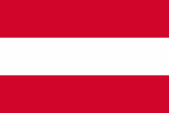
National- and merchant flag,
ratio = 2:3,
Source, by: Dr. Peter Diem www.peter-diem.at






State and official flag and flag of the president,
ratio = 2:3,
Source, by: Dr. Peter Diem www.peter-diem.at







1918–1938
National- and merchant flag,
ratio = 2:3,
Source, by: Dr. Peter Diem www.peter-diem.at






1918–1934
State and official flag and flag of the president,
ratio = 2:3,
Source, by: Dr. Peter Diem www.peter-diem.at






1934–1938
State and official flag and flag of the president,
ratio = 2:3,
Source, by: Dr. Peter Diem www.peter-diem.at




1935–1938
Flag to hoist inland, equally next to the national flag,
ratio = 2:3,
Source, by: Dr. Peter Diem www.peter-diem.at



Flags of the Patrol-Boats (Donau River Fleet):

1918–1926,
ratio = 2:3,
Source, by: Dr. Peter Diem www.peter-diem.at






1918–1926,
ratio = 2:3,
Source, by: Dr. Peter Diem www.peter-diem.at




1934–1938,
ratio = 2:3,
Source, by: Dr. Peter Diem www.peter-diem.at




1955–1984,
ratio = 2:3,
Source, by: Dr. Peter Diem www.peter-diem.at




1984–2006,
ratio = 2:3,
Source, by: Dr. Peter Diem www.peter-diem.at





Flag of the River Police:

1955–1988,
ratio = 2:3,
Source, by:
Jürgen Kaltschmitt




The flag of Austria shows three horizontal stripes in red, white and red. The colours have their roots in the early 13th century became to the colours of the Duchy of Austria (see below for coat of arms) and became finally in the year 1786 introduced as naval and war flag for the whole Austrian Habsburgs territories.
For the German Confederation, which was dominated by Austria, in 1848 was introduced a black-red-golden flag. This flag was officially used only to 1850, but just the Austrian troops presented themselves still in 1864 – in the German-Danish War – under this flag. Since then, the black-red-golden flag embodied, not only in Austria, the pan-German idea, the interconnection of all countries of German language. This became currently relevant again in 1918, after the collapse of Austria-Hungary, as the Republic of German Austria was constituted, which wanted to get involved in an all-German government, which was ultimately in 1919 prevented by the victorious powers of World War I.
On the 12th of November in 1918 the red-white-red flag was introduced and it was maintained untill the annexion of Austria to the German Empire on the 13rd of March in 1938. Even before the capitulation of the German Empire this flag was re-introduced by law on the 1st of May in 1945 as the flag of Austria and confirmed in 1984. The colours combination of red, white and red has its roots in the band-shield of Duke Leopold V. from the House of Babenberg. The legend tells that the shield arised in the year 1191 as the duke after the Battle of Akko took of his belt from his bloody raiment and in this way created the symbol of the white stripe on red undercoat. For the first time proven is the band-shield however on the seal of the last Babenberger Frederick II. in the year 1230.
After the defeat in the First World War occured in Austria-Hungary the revolution. The Habsburg monarchy became overthrowed and on the 12th of November in 1918 was proclaimed the Republic of Austria. The non-German parts of the country separated however in own states (e.g. Hungary, Czechoslovakia ...). As national flag was adoped a flag with three horizontal stripes in red, white and red without a coat of arms. The state flag became added by the depiction of a black eagle with only one head, a mural crown, sickle and hammer (symbols of the bourgeois status, farmers and workers) in the claws and a red-white-red chest shield.
On the 1st of May in 1934 was passed a new constitution as result of the civil war and in this way changed the state flag. There was set the twin-headed Habsburg Eagle in the middle of the flag. Since 1935 it was allowed to hoist the flag the Fatherland Front (FF) inland equally next to the national flag. The FF was a merger of all pro-government groups in Austria, which rejected marxism and national-socialism. This was confirmed on 28th of December in 1936 by the "Law on the federal flag". In practice, however, only the flag of the FF was often used, even without the green rafters at the leech, which should symbolize the Austrian forests. The flag of the FF used the basic structure of the Austrian flag, three stripes in red, white and red, but the flag was added by green rafters at the leech and by a white disk in the middle, on which was to see red edged crook cross. A crook cross is a shortened Jerusalem cross, it was already used by the Republic of Austria from 1925 on coins and medals. By the annexion of Austria to the German Empire on the 13th of March in 1938 was taken over its flag system.
The flags of the federal states of Austria are used with or without the coat of arms. For official use, however, they always show it. The general population is permitted to use this format as well.
Source: Flaggen Wappen Hymnen,
Die Welt der Flaggen,
Volker Preuß,
Jürgen Kaltschmitt


Coat of arms of Austria,
Source, by: Corel Draw 4


1918,
Draft of the coat of arms of the Republic of German-Austria,
Source, by: Jürgen Kaltschmitt

1919–1934,
Coat of arms of the Republic of Austria,
Source, by: Corel Draw 4,
Dr. Peter Diem www.peter-diem.at

1934–1938,
Coat of arms of the Federal State of Austria,
Source, by: Dr. Peter Diem www.peter-diem.at

The coat of arms shows since the 21st of October in 1919 a black eagle with a mural crown, sickle and hammer (symbols of the bourgeois status, farmers and workers), on the chest a red-white-red shield. On the 1st of May in 1934 was this coat of arms substituted by the depiction of a twin-headed Habsburg Eagle.
In 1918, initially another coat of arms was proposed for the Republic of German Austria . It showed a black castle (bourgeoisie), red, crossed hammers (workers) and golden ears of corn (farmers).
From the 13th of March to the 1st of May in 1945 Austriua belonged to the German Empire. After the war was re-introduced the coat of arms of 1919 but added by broken chains on the legs of the eagle as symbol for the liberation from national socialism.
The present arms are set out in the Austrian Constitution (Section 1, article 8a (2)), which states: "The Arms of the Republic of Austria (Federal Arms) are: a free-standing, single-headed eagle sable, armed or and tongued gules, on its breast an escutcheon gules with a fess argent. The eagle bears on its head a mural crown or with three visible towers. Both legs are chained with a broken iron chain. The eagle holds in its right claw a sickle or with the blade turned inwards, and in its left claw a golden hammer."
The shield in the colors red, white and red is also called Bindenschild ("cummerbund"), and it is very old. It came with the same shaped feudal banner of the house of Eppenstein to the house of Traungau in Styria to the house of the Styrian Otakars in 1192 to the house of Babenberg in Austria. The house of Eppenstein was an important noble family, from whose ranks some of the Dukes of Carinthia came. As the house of Eppenstein extincted in 1122, the entire heritage – including coat of arms and the feudal banner – came to the house of Traungau from Styria. The shield finally came to Austria, as the house of Traungau extincted in 1192, and the heritage – with crest and feudal banner again – came to the house of Babenberg, the Dukes of Austria at the time.
However, there is a widespread legend, showing the origin of the shield very descriptively: Leopold V. from the house of Babenberg, Duke of Austria, had participated in the siege of Acre (1189-1191) during the Third Crusade, and he was so violently involved that his tunic cape was completely soaked from the blood of the moors. When he took off his broad sword belt, only a broad white stripe was to see on the garment at this point. Leopold's own banner was lost in the battle, so he got awarded a banner with this picture – three stripes in red, white and red – from Emperor Henry VI. in memory of his exploits. In reality, the king of England throwed his banner in the moat of Acre. But this is another story. Read more → here.
Source: Flaggen Wappen Hymnen,
Volker Preuß,
Jürgen Kaltschmitt

Location:
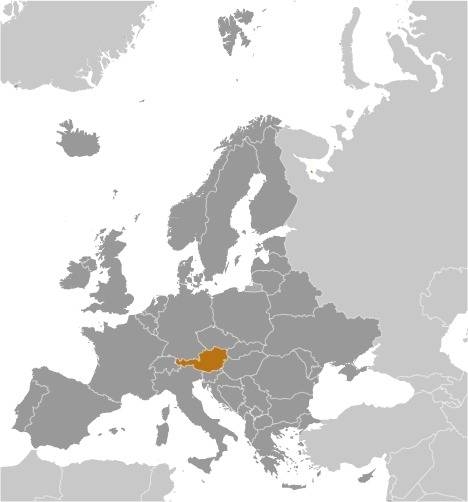
Source: CIA World Factbook
Map of the country:
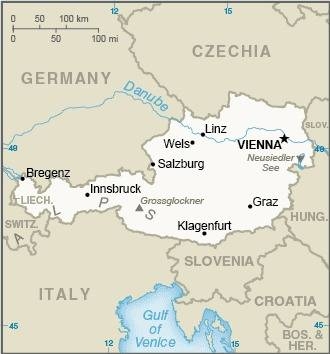
Source: CIA World Factbook
The Federal States of Austria:
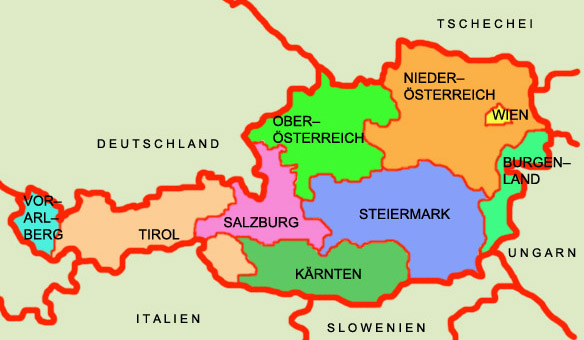
Source: Volker Preuß
• Burgenland
• Carinthia (Kärnten)
• Lower Austria (Niederösterreich)
• Upper Austria (Oberösterreich)
• Salzburg
• Styria (Steiermark)
• Tyrol (Tirol)
• Vorarlberg
• Vienna (Wien)

Area: 32.386 square miles
Inhabitants: 8.858.775 (2019), thereof 87% German speaking Austrians, 2% Slovenes, Croatians, Hungarians
Density of Population: 274 inh./sq.mi.
Religions (2016): 59% Roman Catholic, 3% Protestant, 8% Muslim
Capital: Vienna (Wien), 1.897.500 inh. (2019)
official Language: German
other Languages: Hungarian, Slovenian, Croatian
Currency: 1 Euro = 100 Cent
Time Zone: GMT + 1 h
Source: Wikipedia (D)

antiquity · in the today’s Austria settle Raetians and Celts
since 14 B.C. · Roman conquest, establishment of the Provinces of Noricum and Pannonia superior
166–168 · invasions of the Teutonic tribes of the Marcomans, Quades and Langobardes
233 · invasions of the Quades
254 · invasions of the Marcomans
409–452 · invasions of the Huns
476 · dismissal of the last Roman emperor Romulus Augustulus, end of the (West)Roman Empire, the today's Austria belongs until 553 to the Empires of the Eastern Goth and the Langobardes, settlement by Bayuvares
788 · conquest by the Frankish Empire of the Carolingians
795 · establishment of the "Awarian Mark"
843/870/880 · at the division of the Frankish Empire comes the Awarian Mark to the East Frankish Empire (later called German Empire)
900–955 · invasions of the Hungarians
955 · Battle on the Lech-Field, victory over the Hungarians, formation of the Bavarian Ostmark, in 996 for the first time named "Ostarrîchi"
976 · establishment of the Duchy of Carinthia, of the Margraviate of Ostmark (Austria), Styria and Carniola, the Counties of Tyrol and Goerz, the Arch Diocese of Salzburg, the Diocese of Trient and the Patriarchate of Aquileia
976 · the House of Babenberg becomes Margraves of the Ostmark
1156 · Austria (Oesterreich/Ostmark) becomes a duchy
1180 · Styria becomes a duchy
1192 · Styria comes to the House of Babenberg
1246 · extinction of the Babenbergs, Austria and Styria come to the Bohemian Premyslides
1273 · Rudolf of Habsburg becomes German King
1278 · Rudolf of Habsburg beats the Bohemian Premyslides and acquires Austria and Styria
1335 · the Habsburgs acquire Carinthia and Carniola
1363 · the Habsburgs acquire Tyrol
1374 · the Habsburgs acquire Istria (the coast remains at Venice)
1382 · the Habsburgs acquire Triest
1394 · Carniola becomes a duchy
1438 · the House of Habsburg originates from this year the emperors of the Holy Roman Empire of German Nation (electional empire)
1477 · the Habsburgs acquire the Free County of Burgundy
1496 · the Habsburgs put Spain in custody Spanien by marriage
1500 · the Habsburgs acquire the County of Goerz
1526 · the Habsburgs acquire from the House of Luxemburg by inheritance: Bohemia, Silesia and the Lausitz, as well as after the Battle of Mohács the Hungarian Crown, the Kingdom of Hungary remains between Austria and the Turks as slender stripe, Hungary itself comes to 80% to the Turks
1556 · the House of Habsburg divides itself in a Spanish and in a Austrian line
1683 · repulse of the Turks at Vienna
1697 · Battle of Karlowitz, the Turks have to cede Hungary, Slavonia, Croatia and the Principality of Siebenbuergen to Habsburg
1718 · Peace of Passarowitz, the Habsburgs acquire the Banat
1701–1713 · extinction of the Spanish Habsburgs, Spanish War of Succession
1713 · Peace of Utrecht, the former Spanish Netherlands (Belgium), Sardinia, Naples, Parma and Piacenza come to Austria (House of Habsburg, Austrian line), Spain comes to the House of Bourbon
1740–1748 · Austrian War of Succession, quasi stalemate situation, but Austria loses Silesia to Prussia, Parma and Piacenza to the Spanish Bourbons
1772 · First Polish Division, Austria acquires Galicia
1775 · Austria acquires the Bukovina
1795 · Third Polish Division, Austria acquires Lesser Poland (Western Galicia)
1797–1809 · French Revolutionar Wars, parts of Austria (Styria) become occupied by the French in 1797
1797 · Peace of Campo Fòrmio after the French Revolutionar Wars, Austria loses the Austrian Nethterlands and the Lombardy, but acquires the Republic of Venice (Venetia)
1803 · German Mediatisation (Reichsdeputationshauptschluss), Austria gets Trient and Brixen
1804 · Franz II. of Habsburg, Emperor of the Holy Roman Empire of German Nation becomes as Franz I. also Emperor of Austria, foundation of the Empire of Austria
1805 · Peace of Pressburg after the 3rd Coalition War, Austria loses Venice, Tyrol and Vorarlberg
1806 · Emperor Franz II. resigns the crown of the Holy Roman Empire of German Nation, the German Empire ends
1809 · Peace of Vienna, Austria loses Salzburg, the Inn Quarter, Western Galicia and parts of Eastern Galicia and cedes Istria, Trieste, Gorizia, Carniola, Carinthia, Croatia, and Dalmatia to France, which were merged in 1810 to the French "Illyrian Provinces"
1813 · declaration of war to France (Napoléon)
1814 · Congress of Vienna, the Empire of Austria (House of Habsburg) acquires back the in 1809 lost territories, they become merged to the Habsburg's Kingdom of Illyria, Dalmatia and Croatia become re-annexed to Hungary (under the Habsburgs, part of the Empire of Austria), Austria gets the presidency of the German Confederation from 1815
1848/1849 · revolution in Vienna, civil war between Hungarians and Croats, riotings in Prague, Mailand and Venice, as a result of that Emperor Ferdinand I. resigns and Franz Joseph I. of Habsburg becomes new Emperor, the riotings become suppressed and he enacts a new constitution: the titular hereditary territories of the Habsburgs in the Austrian Empire become converted to crown lands with their own Landtag (parliament), the Landtag of Dalmatia rejects the annexion to Croatia, the Kingdom of Dalmatia becomes an own crown land of the Austrian crown, Croatia and Slavonia become united to the "Kingdom of Croatia and Slavonia", which remains as a subsidiary country under the Hungarian crown
1859 · Austria loses the Lombardy to Sardinia
1866 · Fratricidal War (Prussia against the German Confederation), Prussia triumphs, shattering of the German Confederation, Austria loses Venice, establishment of the North German Confederation (without Austria) under the leadership of Prussia
8th of February 1867 · Austro-Hungarian Compromise, equal rights for both parts of the empire, nascence of the double monarchy of Austria-Hungary, Austria: consisting of the Austrian crown lands, Hungary: consisting of Hungary itself and its subsidiary countries, the House of Habsburg sets in one person the Emperor of Austria and the King of Hungary, establishment of common ministries in foreign affairs, finance and defense
1878 · Berlin Congress, Austria-Hungary acquires Bosnia (including Herzegovina)
1908 · Bosnia becomes affiliated to Austria-Hungary as a Reichsland (empire's country)
28th of June 1914 · assassination of the Austrian throne successor Franz Ferdinand and of his wife, onset of the First World War (1914–1918), the German Empire is thereby an ally of Austria
28th of October 1918 · separation of Czechoslovakia
19th of October 1918 · separation of Yugoslavia
1st of November 1918 · separation of Hungary
3rd of November 1918 · cease fire
11th of November 1918 · Emperor Karl (Charles) I., renounces in Austria for the exertion of his reign
12th of November 1918 · proclamation of German Austria to the Republic of Austria as component of the „German Republic“
13th of November 1918 · Karl IV. (Karl I.), renounces in Hungary temporary for the exertion of his reign, end of the Habsburg monarchy
10th of September 1919 · Peace Treaty of Saint-Germain, cede of Southern Tirol and German territories in Bohemia, recognition of Czechoslovakia, Poland, Hungary and Yugoslavia, renounce for a joining to the German Empire, payment of huge reparations
1920–1934 · phase of economical crisises and civil war
1st of May 1934 · new constitution, the name "Republic of Austria" is abolished and replaced with "Federal State of Austria"
11th of March 1938 · seizure of power by the national-socialist Seyß-Inquart
13th of March 1938 · annexion of Austria to the German Empire, renaming in "Ostmark"
1939–1945 · Second World War
27th of April 1945 · proclamation of the Republic of Austria "Second Republic"
May 1945 · the Ostmark becomes completely occupied by allied troops
15th of May 1955 · state's treaty, full sovereignty by perennial neutrality
1st of January 1995 · joining of Austria to the European Union (EU)
3rd of October 1999 · elections for Parlament, new government
4th of February 2000 · the EU recognizes not the results of the democratic formation of government and imposes sanctions against Austria
12th of September 2000 · the sanctions of the EU against Austria have to abolish
Source: Atlas zur Geschichte,
Wikipedia (D),
World Statesmen,
RetroLib Retrobibliothek,
Discovery '97,
Weltgeschichte,
Volker Preuß

Map ca. 1910:
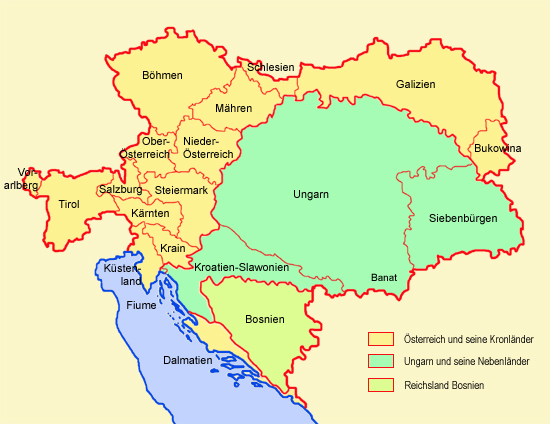
Source: Volker Preuß

Further Austria pages (historical Flags and Coats of Arms):
• Empire of the Austrian Habsburgs (to 1804)
• Empire of Austria (1814–1867)
• Austria-Hungary (1867–1918)
The name "Österreich" means "Eastern Reich". This name has its roots in the by Charles the Great in the year 795 established "Awarian Mark" which became established anew by Otto the Great in the year 955 as "Bavarian East Mark". That "East Mark" was in the year 996 documentarily mentioned for the first time as "Ostarrîchi" ergo "Ost Reich (East Reich)". The denomination "Austria" has Latin roots and goes back to the word "auster" what however means "South". Ergo "Österreich" means "Eastern Land" and "Austria" means "Southern Land".
Source: Handbuch der geographischen Namen,
Atlas der wahren Namen


![]()


















































